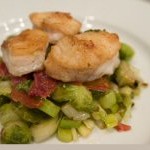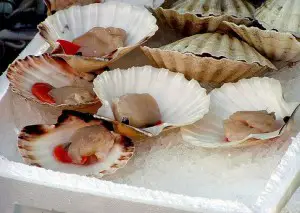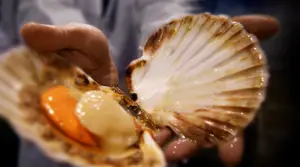 Last night we hosted a little dinner with some friends who have eaten with us before. It was actually a bit like an unofficial meeting of the conseil syndical de copropriété (the elected committee that help administer the day-to-day running of the apartment buildings). The conseil syndical ensures that lightbulbs are replaced, graffitti is painted over, cleaning is done properly, lifts work, doors and locks are maintained, and other stuff like that. They are elected each year at an AGM of all the owners and last night we had Yvon, Louis and M-D who are already on this committee, Pascale who is putting herself forward for election this year, Louis’ lovely wife, Monique, and of course, myself. So after a short spell on the balcony looking across the whole résidence (photo above), and then an aperitif in comfy chairs, we settled in for some serious eating!
Last night we hosted a little dinner with some friends who have eaten with us before. It was actually a bit like an unofficial meeting of the conseil syndical de copropriété (the elected committee that help administer the day-to-day running of the apartment buildings). The conseil syndical ensures that lightbulbs are replaced, graffitti is painted over, cleaning is done properly, lifts work, doors and locks are maintained, and other stuff like that. They are elected each year at an AGM of all the owners and last night we had Yvon, Louis and M-D who are already on this committee, Pascale who is putting herself forward for election this year, Louis’ lovely wife, Monique, and of course, myself. So after a short spell on the balcony looking across the whole résidence (photo above), and then an aperitif in comfy chairs, we settled in for some serious eating!
 Starter was nice and simple – foie gras and roulades de Jambon au foie de canard en gelée au sauternes. And if you are wondering what that is, it’s foie gras rolled in ham which we get from Godard, France (they will mail all over the world). In fact, we were cheating a little because our foie gras was maybe not quite enough for six and the “roulades” augmented the plate and seemed like we were also offering more choice (no good getting old if you don’t get sneaky with it!)
Starter was nice and simple – foie gras and roulades de Jambon au foie de canard en gelée au sauternes. And if you are wondering what that is, it’s foie gras rolled in ham which we get from Godard, France (they will mail all over the world). In fact, we were cheating a little because our foie gras was maybe not quite enough for six and the “roulades” augmented the plate and seemed like we were also offering more choice (no good getting old if you don’t get sneaky with it!)
 Main course was a repeat of something we have done before (for other people), monkfish medallions a l’orange (Monkfish in Orange Sauce). Monkfish is sometimes called “The Poor Man’s Lobster” since it has a nice firm flesh and is so very, very tasty. With it, we served Champ and Braised Fennel. And what a success it was… so much so that both Monique and Pascale asked for a copy of the recipe (a sure sign that something has been appreciated). And for Monique, it seems it was the first time she had even eaten fennel, so another first!
Main course was a repeat of something we have done before (for other people), monkfish medallions a l’orange (Monkfish in Orange Sauce). Monkfish is sometimes called “The Poor Man’s Lobster” since it has a nice firm flesh and is so very, very tasty. With it, we served Champ and Braised Fennel. And what a success it was… so much so that both Monique and Pascale asked for a copy of the recipe (a sure sign that something has been appreciated). And for Monique, it seems it was the first time she had even eaten fennel, so another first!
With the foie gras, we served a sauterne – a Barsac called Cyprès de Climens 2004 which, I confess, hit the spot rather nicely. With the fish, we served one of our “easy-going” favourites, Duc de Morny 2012 Picpoul de Pinet. Though, Yvon doesn’t drink white wine so we served him a rather succulent red wine called “Bordeaux Origami”. It’s one of the Grand Vin de Bordeaux from Famille Capdevielle and is almost totally unknown but (quite correctly) scores high in all the good wine guides. It’s a young wine (2011) but has a really deep, rich quality that you normally associate with older, more expensive wines.
 After a course of cheese and salad, for dessert, we served another of our old favourites, Raspberry and Caramel Crunch which never fails to please. In fact, Monique (who has a notoriously small appetite) was last seen scraping her dish and looking somewhat sad that there was none left!
After a course of cheese and salad, for dessert, we served another of our old favourites, Raspberry and Caramel Crunch which never fails to please. In fact, Monique (who has a notoriously small appetite) was last seen scraping her dish and looking somewhat sad that there was none left!
I thought I had cooked enough of everything for more than six people, but very little remained at the end of the evening. So, a very pleasant “meeting” of the conseil syndical, full of good food and plenty of good humour. All meetings should be like that!… and guess who had left-over monkfish medallions for lunch today????
 So to walk it all off, M-D and I went for an afternoon ‘constitutional’ along the river Seine this afternoon. The massive locks there are for the big barges that use the river (some of them up to 100m long) for moving mostly sand and shingle. It’s fascinating watching them manoeuvre into the locks which have a height difference of about 4 metres at this point.
So to walk it all off, M-D and I went for an afternoon ‘constitutional’ along the river Seine this afternoon. The massive locks there are for the big barges that use the river (some of them up to 100m long) for moving mostly sand and shingle. It’s fascinating watching them manoeuvre into the locks which have a height difference of about 4 metres at this point.  While walking, I spotted a brightly-coloured wood nymph! (see left).
While walking, I spotted a brightly-coloured wood nymph! (see left).
And then, this evening just to round it all off, we had a simple, but tasty Tarte flambée (also called Flammekueche) – an Alsatian dish composed of bread dough rolled out very thin, which is covered with fromage blanc or crème fraîche, thinly sliced onions and lardons. It is one of the most famous specialties of the region. So – a very pleasnt 24 hours!
 Of course, your fishmonger will open your scallops for you. In fact, they mostly sell just the flesh. But there is seriously nothing better than a FRESH scallop, as we discovered the other day as we went to the market. Most people are simply afraid of what’s inside a scallop and are not sure what to keep and what to throw away, but it’s drop-dead simple, and here’s how you do it…
Of course, your fishmonger will open your scallops for you. In fact, they mostly sell just the flesh. But there is seriously nothing better than a FRESH scallop, as we discovered the other day as we went to the market. Most people are simply afraid of what’s inside a scallop and are not sure what to keep and what to throw away, but it’s drop-dead simple, and here’s how you do it… You will now be left with just the edible muscle, though it may be a little gritty with sand, which you can easily rinse off under cold running water. Now you are free to eat them raw from the shell or create any one of a dozen delicious recipes like my favourite,
You will now be left with just the edible muscle, though it may be a little gritty with sand, which you can easily rinse off under cold running water. Now you are free to eat them raw from the shell or create any one of a dozen delicious recipes like my favourite,